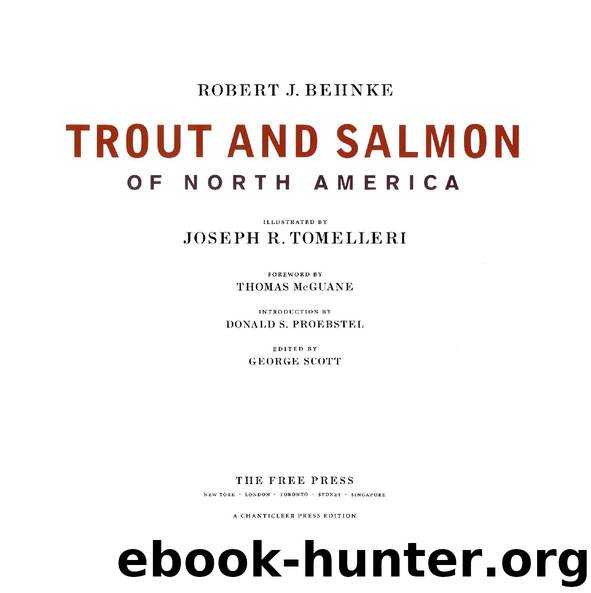Trout and Salmon of North America by Robert Behnke Joe Tomelleri & Thomas McGuane

Author:Robert Behnke, Joe Tomelleri & Thomas McGuane
Language: eng
Format: epub
Publisher: Free Press
Hybridization between native cutthroat trout and introduced rainbow trout downstream from Palisades Reservoir is well documented, and genetic monitoring has shown that the rate of hybridization has increased in recent years. It is unlikely that before rainbow trout were stocked and before Palisades Dam blocked movement of fish in the Snake River, the size of the spots on the finespotted cutthroat trout became larger at the Wyoming-Idaho border.
EVOLUTION AND CLASSIFICATION The origin of the Snake River finespotted cutthroat trout probably occurred during the later stages of the last glacial period, about 20,000 years ago. During this period, ice-dam and/or landslide lakes in the upper Snake River system created opportunities for the isolation of a population of largespotted cutthroat trout and their evolutionary change into finespotted cutthroat trout. Breeding experiments in Norway with brown trout found that the genetic basis for large spots or very small spots, comparable in size to the spots of Snake River finespotted cutthroat trout, is due to different forms of a gene (called alleles) at a single gene locus.
There has been a relatively short geological time of divergence and probable occasional hybridization and genetic interchange between finespotted and largespotted cutthroat trout, and no diagnostic genetic marker has yet been found that can identify one subspecies from the other. But an observer can distinguish the two subspecies by looking at specimens and observing the striking distinction between finespotted and largespotted trout.
It is unusual that such a distinctive trout was not commonly recognized historically. In the late nineteenth century the U.S. Fish Commission conducted two surveys and collected fish in the upper Snake River system, but all localities studied—Heart Lake, Henrys Lake, Pacific Creek, and the Portneuf River—had only the largespotted Yellowstone subspecies. The first published reference to the finespotted cutthroat of which I am aware is in a 1970 revised edition of the Wyoming Game and Fish Bulletin: Wyoming Fishes, which has photographs of both the Yellowstone cutthroat and the Snake River finespotted cutthroat. It is mentioned that the distinctive finespotted cutthroat is “worthy of recognition.”
If it weren’t for the distinction in the size of spots of the finespotted and largespotted cutthroat trout in the upper Snake River system, the reality of the coexistence of the two forms would not be known. As mentioned, no genetic distinctions have been found that can identify one form from the other. The lack of a known genetic distinction can easily lead to a wrong conclusion: If no differences can be found by modern methods of genetic analysis, then there are no genetic (hereditary) differences.
That such a conclusion is obviously wrong can be seen in the size of the spots that clearly differentiate between largespotted and finespotted cutthroat trout, and the consistent and stable pattern of nonoverlapping distributions of the two forms. The genetic or hereditary basis for the size of spots can be observed in hatchery propagation: Largespotted cutthroat trout give rise to largespotted offspring, and finespotted cutthroat produce finespotted offspring.
Extremely slight genetic differences are often not detectable by the
Download
This site does not store any files on its server. We only index and link to content provided by other sites. Please contact the content providers to delete copyright contents if any and email us, we'll remove relevant links or contents immediately.
Sapiens: A Brief History of Humankind by Yuval Noah Harari(14248)
The Tidewater Tales by John Barth(12608)
Mastermind: How to Think Like Sherlock Holmes by Maria Konnikova(7223)
Do No Harm Stories of Life, Death and Brain Surgery by Henry Marsh(6887)
The Thirst by Nesbo Jo(6826)
Why We Sleep: Unlocking the Power of Sleep and Dreams by Matthew Walker(6618)
Life 3.0: Being Human in the Age of Artificial Intelligence by Tegmark Max(5474)
Sapiens by Yuval Noah Harari(5293)
The Longevity Diet by Valter Longo(5017)
The Body: A Guide for Occupants by Bill Bryson(4973)
The Rules Do Not Apply by Ariel Levy(4847)
The Immortal Life of Henrietta Lacks by Rebecca Skloot(4525)
Animal Frequency by Melissa Alvarez(4394)
Why We Sleep by Matthew Walker(4358)
The Hacking of the American Mind by Robert H. Lustig(4318)
Yoga Anatomy by Kaminoff Leslie(4303)
All Creatures Great and Small by James Herriot(4230)
Double Down (Diary of a Wimpy Kid Book 11) by Jeff Kinney(4204)
Barron's AP Biology by Goldberg M.S. Deborah T(4095)
